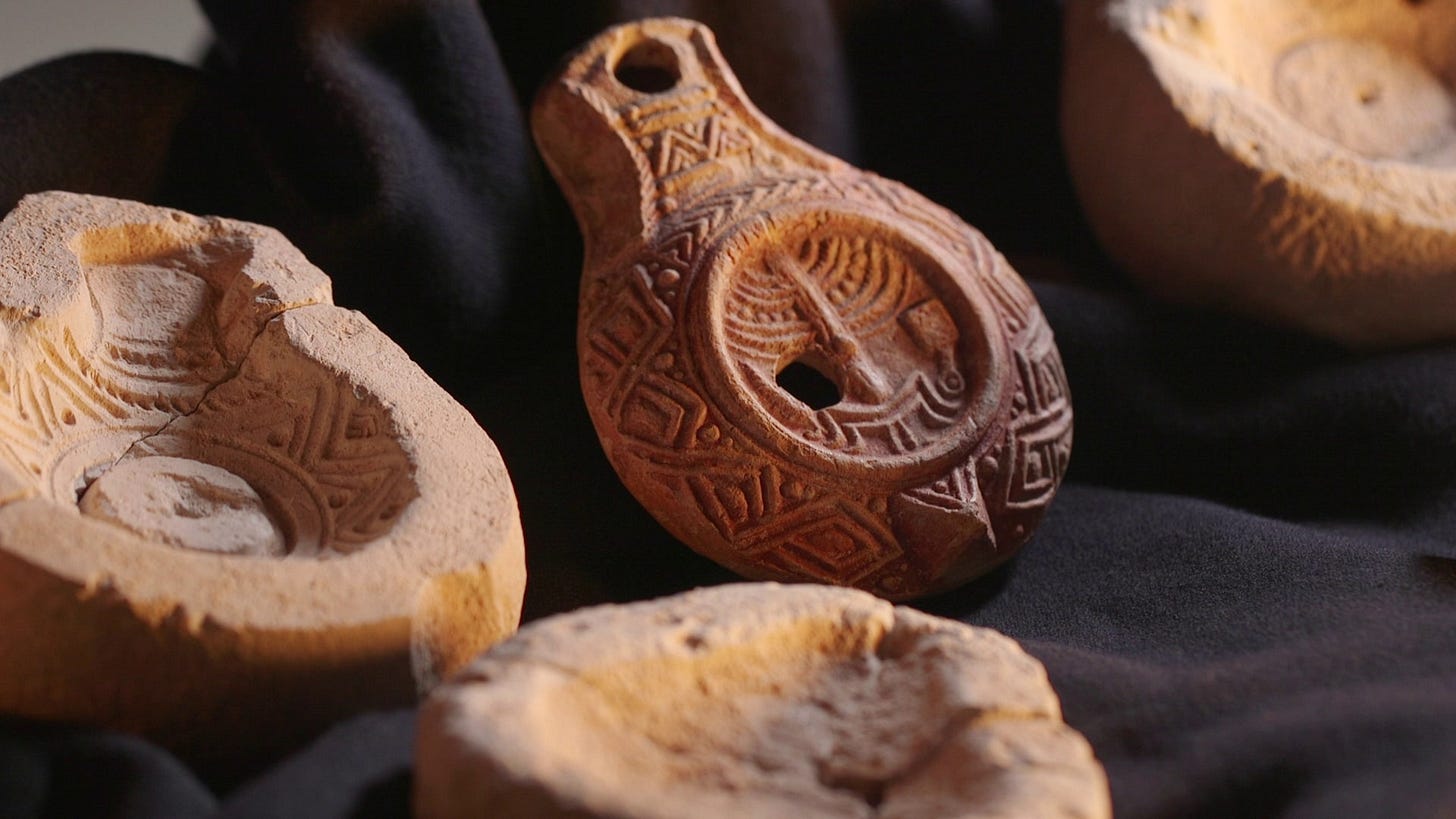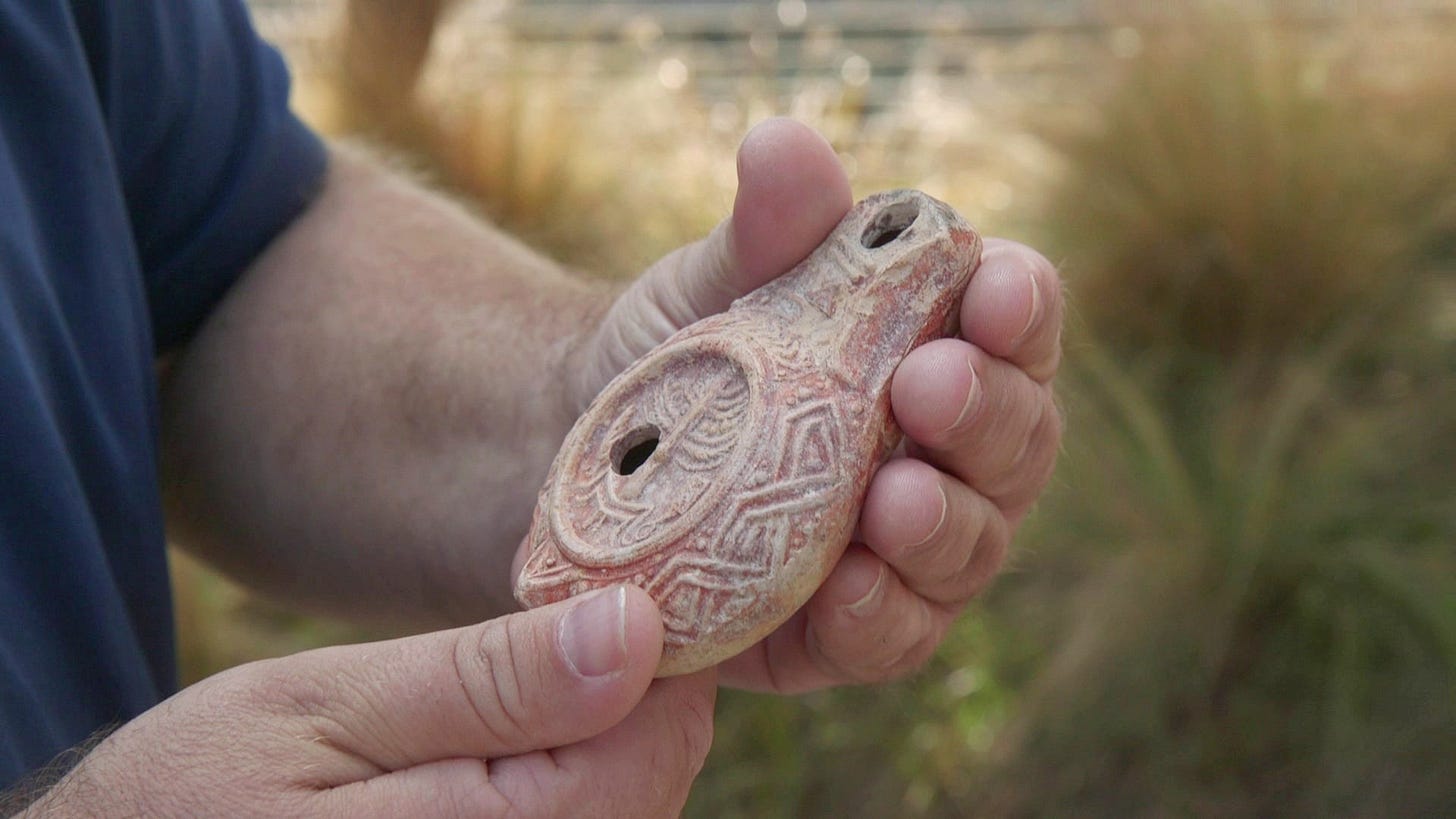New Mossad Coup: Time Travel to 2nd Century Palestina - Video Expose'
Their latest "Time Bandits"-level chronological treachery dwarfs the recent decade-long exploding Hezbollah beepers operation. Oh, the perfidy of the (((Joos)))!
Once again ladies and gents: the nefarious Israeli Mossad, in yet another shocking Middle Eastern espionage plot, succeeded in traveling two millenia back in time in order to deviously secrete so-called "evidence" of a dubious Jewish presence in 2nd century Palestina:
"A rare ceramic oil lamp from the Late Roman period, decorated with depictions of the Temple menorah, incense shovel and lulav (date palm branch used in Jewish ritual), was recently uncovered during an Israel Antiquities Authority archaeological dig near the Mount of Olives in Jerusalem. This unique find, which, judging by the soot marks on its nozzle, was used for lighting about 1,700 years ago, provides a fascinating glimpse into Jewish cultural and religious life during this period.
"The spectacular oil lamp will be presented to the public for the first time at the Jay and Jeanie Schottenstein National Campus for the Archaeology of Israel during the upcoming Hanukkah holiday as part of the Ministry of Heritage conference. The researchers: ‘Just as today many of us possess objects of Jewish significance, so did the lamp’s owner, some 200 years after the Temple’s destruction.’
"The exquisite artistic workmanship of the lamp, which was found complete, makes it an outstanding and extremely rare ” says Michael Chernin, excavation director on behalf of the Israel Antiquities Authority. “The menorah, incense shovel and lulav are symbols associated with the Jewish connection to the Temple. This finding is particularly surprising, since, we have very little evidence of the existence of a Jewish settlement in and around Jerusalem from this period. After the Roman emperor Hadrian suppressed the Bar Kochba rebellion in 135 CE, Jews were expelled from the city. The Mount of Olives lamp is one of the few material traces of a Jewish presence around Jerusalem in the 3rd-5th centuries CE.”
“According to Benjamin Storchan, Israel Antiquities Authority research archaeologist, the lamp belongs to the “Beit Nattif” type, ‘named after is production workshop identified in the 1930's near Bet Shemesh. The nozzle and lamp shoulders were decorated with geometric designs and the center features a detailed deception of the seven branched menorah with a tripod base. Oil lamps with menorah decorations are exceedingly rare and only a few similar Beit Nattif type lamps can be found in the National Treasures archive. The choice of symbols on the lamp is not accidental. This is a fascinating testimony connecting everyday objects and faiths among ancient Jerusalem’s inhabitants. It seems that the lamp belonged to a Jew, who purchased it because of its religious affiliation and memorial to the Temple.’
"It is evident that the lamp maker dedicated a great deal of time and effort to its decoration" adds Storchan. "The lamp was made using delicately and intricately carved limestone molds using drills and chisels. The molds were made in two parts (upper and lower). To create the lamp, the potter pressed the clay into the molds then pressed together. Finally, the vessel was fired, and it could be used. This method of producing lamps in molds allowed for refined designs, as well as the addition of delicate and intricate decorations."
“The Temple menorah became a Jewish symbol in the Second Temple period. However, after the Temple’s destruction, the menorah image became an important icon in the Jewish collective memory both within Israel and the Diaspora. The menorah occasionally appears on personal objects such as oil lamps, which – being an illumination vessel, perhaps evoked a feeling of lighting the Temple menorah.
Minister of Heritage Rabbi Amichai Eliyahu, “This unique oil lamp, which in an exciting manner bears the symbols of the Temple, connects the lights of the past with the Chanukah holiday of today, and expresses the deep and long-standing connection of the nation of Israel to its heritage and to the Temple’s memory.”
This report —recorded in our homefront “mamad” bomb shelter perch in the northern Galilee—will be updated as events dictate. Meanwhile, please feel free to share this post, subscribe, and help support my efforts to bring you accurate, sourced reporting, and close-up-and-personal slice-of-life scenes here in northern Israel and our Life on the Border - thank you for your consideration:
Join the Journey - Subscribe for Unfiltered Narratives & Timeless Photography: Substack’s Stripe payment system isn’t available in Israel, so I’ve arranged an alternative for you to support my work. If you’re feeling generous, you can donate via PayPal: https://www.paypal.com/donate/?hosted_button_id=YX324K9MDK6MC&utm_source=substack&utm_medium=email
My articles will remain accessible to everyone, but if you choose to contribute, know that it helps me keep doing what I love—bringing these stories to life. Your support means the world to me.
Keep the stories alive with your support, and let’s keep brewing the narrative together. Until next time, stay curious and connected.
Warm regards,
Dave Bender
Thanks for reading Davidbrianbender.com! This post is public so feel free to share it:







Nice find and well written. Seeing artifacts as I watch videos a link took me to Bone clone where they sell replica skulls from elongated human skulls to hippo. Hopefully an entrepreneurial Israeli is creating these and helping put shekels in Israeli pockets.
The Smithsonian somehow makes accessible dimensions and such for their artifacts for those who are 3D printing or are just curious and wish to carve or create or know.
Thanks David, what a wonderful and fascinating find. I imagine olive oil was used. I tried a homemade olive oil lamp, and definitely appreciate the technology advances. 🕎